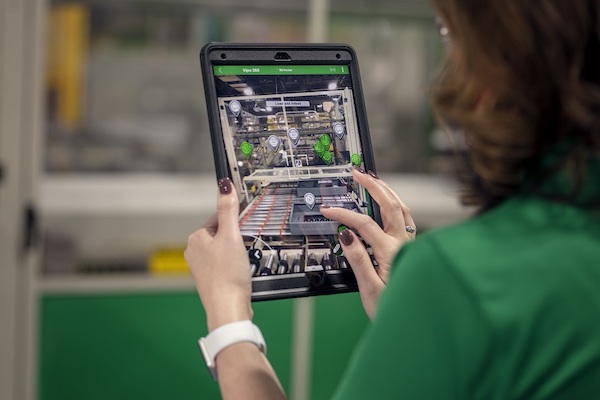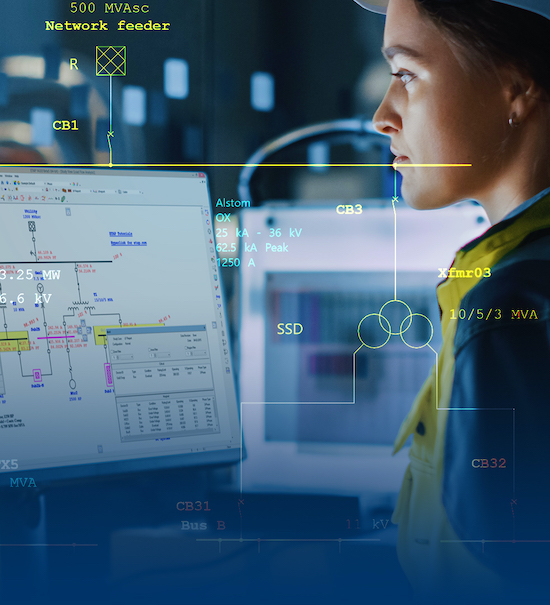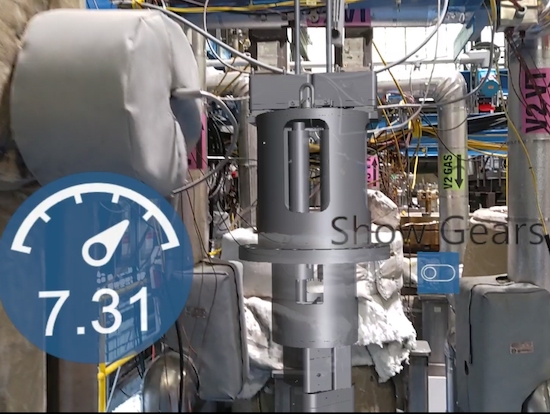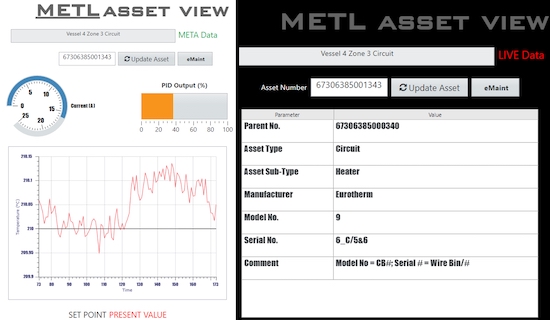Utilities Get Digitized
XR and gaming technologies breathe new life into the power sector.

Fig. 3: Augmented reality combines contextual and local dynamic views via a natural, intuitive interface that superimposes real-time data and virtual objects onto equipment or machinery, giving operators immediate access to relevant machine and process information. Image courtesy of Schneider Electric.
Latest News
July 21, 2023
Hamstrung by an aging infrastructure, bracing for a workforce crisis, and contending with growing demand, the power and utility sector is struggling to overcome challenges that even now impede its ability to provide the U.S. with electricity. Too many of these companies are simply not prepared to meet the demands of the future.
Leading experts in the sector, however, now contend that advanced technology deployment, such as gaming technology, extended reality (XR) devices and digital twin systems could provide the means to weather the current spate of challenges. Furthermore, the new tools promise to help utilities’ digitization initiatives gain momentum (Fig. 1).

Fig. 1: Using video gaming technologies, extended reality devices and digital twin platforms, the power and utility sector is gaining visibility to enhance operational and maintenance efficiency, and improve recruiting, training and retention efforts. Image courtesy of Schneider Electric.
Staffing Problems and Loss of Knowledge
The crisis stems primarily from shortfalls in two key areas. The first revolves around the convergence of an aging workforce and sluggish recruiting and retention.
The power and utilities sector is currently experiencing the highest retirement rate in the energy industry, with 50% of the workforce set to retire over the next 10 years. This exodus translates into a massive loss of field technicians, operators, engineers and managers, which creates a crippling deficit of critical knowledge.
Compounding the problem, millennials have shown a lack of interest in working in this sector. The inability of utilities to attract employees can be attributed in part to the fact that the new generation of potential employees views work in the sector as unappealing and dangerous.
The root of this view lies in the fact that this generation of job seekers has different skills and expectations. They come from a background in which computers and mobile devices are ubiquitous and interfaces are graphical and intuitive. They’re very familiar with video games, digital paths to information and rich data visualization. So, when millennials approach employment opportunities, they come with the expectation of a modern, technologically sophisticated workplace.
All too often, however, they find facilities mired in legacy systems and outmoded methods and processes. Electronics-savvy millennials find these systems to be as challenging to navigate as paper-based records.
This technological culture clash proves to be a significant obstacle, which not only impedes recruiting but also erodes retention of promising employees. Companies in general, and utilities in particular, cannot attract new employees with business-as-usual strategies.
New candidates entering the workforce are looking for more than a company with a strong mission and vision. They are looking for a company that can provide them with the latest technology and a strong infrastructure to support their daily work.
“Potential employees entering the workforce grew up enjoying fast internet, playing video games and doing everything online,” says Stephanie Brandenburg, director of offer innovation at Schneider Electric. “To bring them into a position and then give them the equivalent of a dial-up line is unlikely to keep them on the company payroll for very long.”
Deploying Tools for a Modern Workforce
So, what can utility companies do to attract, engage and retain the latest generation of workers? One approach put forth in an Argonne National Laboratory (ANL) report titled “Deploying Extended Reality for Digital Operations and Maintenance at the Mechanisms Engineering Test Loop” advocates focusing recruitment and training on interest in and familiarity with personal devices and video game technology.
This translates into deploying visualization tools that provide data access through easy-to-use, richly graphical technologies that bridge the gap between the physical and digital worlds. By leveraging XR systems, gaming technology and digital twin, the ANL engineers contend that power plant managers will be able to create work environments that will boost recruitment to levels that will enable them to move forward into the future.
“In today’s digital age, we’re using virtual reality to attract and recruit top talent,” says Richard Donaldson, vice president of digital transformation and enterprise data at Duke Energy. “We created a workforce development simulation that immerses students at career and college fairs into a virtual game in which they are tasked with restoring power to a city. With a look inside power restoration and Duke Energy’s innovative culture, we’re planting seeds of interest that could grow the next generation of line workers.”
The use of XR devices, complemented with gaming and digital twin technologies, makes work more realistic and engaging, and it allows the employee to improve decision-making skills, boost response times, enhance familiarity with safety protocols and make mistakes in a safe environment. It allows employees to learn the necessary lessons so that they are ready when the actual situations arise.
“A 2020 PricewaterhouseCoopers study showed virtual reality learners are four times more focused than e-learning students and 275% more confident in applying the skills after training,” says Donaldson. “We have found that on average, it is four times faster to train in the VR headset environment over traditional computer-based training while also saving an average of $500,000 per year in operational costs, including travel and instructor expenses—approximately $126.50 in savings per user.”
Such technologies also help retain current employees and let them grow and build their skills. Furthermore, leveraging these tools enables experienced workers to share their knowledge with newer employees.
“This type of platform can allow more seasoned employees to share their experiences in a practical forum by mentoring younger team members through training,” says Brandenburg. Sharing that institutional knowledge in an augmented reality format can really be effective because it provides context vs. being hypothetical. How do you explain a critical event and what you have done in it in a compelling way? Why not simulate it, and have the experts who lived through it demonstrate what they learned to others. This could help companies avoid the ‘brain drain.’”
A digital platform also allows this to be done over distance. For example, if you have an employee with 20-plus years of experience in Houston, they can mentor others beyond that facility virtually, sharing knowledge to help build the skills of employees in any location.
Time for New Systems
The second shortcoming facing utilities is the fact that much of the current infrastructure dates back to the 1960s and 1970s and strains to meet the growing demand for electricity. Many dated software systems are bloated and ill-suited for a landscape increasingly dominated by the Internet of Things (IoT), big data and a greatly expanded variety of data sources, including sensors and mobile devices.
Platform obsolescence and inherent incompatibility with newer systems make legacy platforms a significant barrier to improving performance, achieving greater efficiency and meeting growing demand for electricity.
Power and utility experts, however, assert that an infusion of the same technologies that promise to improve recruiting, training, and retention can also improve power plant operational and maintenance efficiency.
Greater Visibility Translates into Better Decision Making
The consumer visualization hardware and software advocated by digitization proponents offer many opportunities to greatly improve power plant operations and maintenance.
“Equipping frontline workers with extended reality hardware makes information typically accessed from a console readily available to them without having to haul around a laptop or mobile device,” says Derek Kultgen, mechanisms engineering test loop (METL) group leader and principal mechanical engineer at ANL.
“Using head mounted tablets, METL technicians can monitor an asset’s performance without assistance from control room operators or shift supervisors,” Kultgen says. “They simply scan an asset’s QR code with the head mounted tablet, and they are able to view the assets’ sensor trends, meta data—such as serial number or manufacturer—and maintenance history.”
XR technology’s visibility also enhances utility employees’ ability to collaborate with other internal staff and external vendors and experts.
“If you have an operator performing troubleshooting tasks, VR software allows other colleagues or vendors to see and experience the same space as the operator on the physical site,” says Brandenburg. “Couple that with augmented reality, and you now have fully immersive and intuitive visualization tools that provide real-time access to information, enabling operators and technicians to visualize complex systems, troubleshoot issues and streamline maintenance tasks.”

Fig. 2: This mixed-reality visualization of Argonne National Laboratory’s Gear Test Assembly (GTA) enables operators to walk the test vessel while viewing an augmented CAD model of GTA and a gauge/numerical indicator displaying vibration data. The user can press a virtual button and make housings, support structures and hardware transparent to reveal gears. Image courtesy of Argonne National Laboratory.
An example of this might involve the use of XR devices in nuclear power plant inspections and maintenance activities. Technicians wearing mixed-reality headsets can use the technology to overlay digital information onto physical equipment, displaying live data, maintenance procedures and diagnostics (Fig. 2). This hands-free access to information enhances efficiency, reduces human errors and improves overall maintenance effectiveness.
Enhancing Visualizations With Digital Twin
Visualizations can be enriched with data from physics-informed, IoT-powered digital twins, leveraging the data provided by the growing number of metrology instruments residing in today’s power plants.
“Duke Energy uses high-tech laser scanning hardware to gather thousands of measurements that are then converted into data points, which are ‘stitched’ together using compatible software,” says Donaldson. “The result is a technically identical digital twin of the facility.”
Applying digital twins to the utilities sector lets power plant managers and engineers gain a comprehensive understanding of assets’ performance, enabling proactive decision-making and maintenance optimization. For example, conventional power plants can use digital twin technology to create virtual replicas of turbines, generators and other critical components.
“By integrating data from sensors, SCADA and DCS systems, and historical records, operators can monitor equipment health, identify anomalies, and predict maintenance requirements,” says Brandenburg (Fig. 3). “This proactive approach minimizes unplanned downtime, optimizes maintenance schedules, reduces costs and improves overall operational efficiency.”
Armed with the data aggregated in the digital twins, plant engineers can perform complete 3D simulations of operating facilities, which enables them to enhance response preparedness, efficiency and safety while helping to reduce costs.
“The real-world data that these immersive simulations provide can help facilities predict what may happen in their specific environments,” says Donaldson. “That knowledge can enable them to coordinate complex tasks across locations and multi-disciplinary staff, saving time and money, enhancing safety, and mitigating risks. Immersive simulators for power plants can also serve as critical assets for outage planning and detecting unforeseen difficulties that, if not caught, could have significant financial impacts.”
The power of visualization and digital twin technologies, however, extends beyond improving operational and maintenance efficiency.
“Virtual reality and [augmented reality] technologies can aid in the design and layout planning of power generation facilities,” says Daniela Sellmann, global vice president and head of utilities at SAP. “By visualizing equipment placement, maintenance access points, and safety considerations in a virtual environment, operators can optimize space utilization, improve safety measures and identify potential design flaws before construction.”
The Real Power Behind the Tools
While visualization and digital twin technologies individually provide valuable insights into power plant operations and maintenance requirements, the total impact of all the technologies working in concert brings acuity that reads between the lines to deliver even greater insights.
“Gaming software, digital twin technology and other visualization tools like XR bring together advanced analytics, machine learning and AI to test operations in the context of the real world,” says Brandenburg. “By creating virtual environments that simulate real-world power plants, operators and technicians can undergo realistic training scenarios, conduct equipment simulations, and optimize processes before implementation in the physical plant.”
Furthermore, this trend can help plant managers optimize their systems, map out the best options for upgrading equipment or enhance technologies well before purchase or new equipment selection.
“In my mind, it’s the combination of real-time and advanced analytics, pulling and processing the data to provide insights,” says Brandenburg. “As rates fluctuate, being able to predict events would be very valuable to an operator. With that insight, they can provide a more straightforward flow of power to customers, regardless of the source of that power. Operators would be able to more seamlessly leverage wind, solar, water and fossil fuel, at different rates and different capacities, to meet that fluctuating demand.”
Making Visualization Even More Powerful
As impressive as the current crop of visualization technologies is, complementary technologies emerging from the wings promise to take visualization tools to a higher level of performance.
“Voice activation and advanced optics have the potential to significantly enhance the benefits of XR devices for power plant operations, maintenance, training and recruitment,” says Greg Elliott, pre-sales solutions consultant, energy and utilities, at Siemens Digital Industries Software.
This view is borne out by the experience gained from pilot and test projects. “Experience garnered from extended reality activities at METL has convinced our team that voice activation (Fig. 4) is a necessity for frontline workers,” says Kultgen. “Operators and trainees generally work in an environment where consoles and arguably even mobile devices are impractical for frontline men and women who need to access information while using both of their hands to repair, replace, or troubleshoot.”

By allowing users to interact with XR devices using voice commands, voice activation technology eliminates the need for physical input devices.
“Voice activation can simplify and streamline tasks by enabling hands-free control of XR devices,” says Elliott. “For example, technicians wearing XR headsets can use voice commands to access information, pull up schematics, check equipment status or initiate maintenance procedures without needing to use their hands. This improves efficiency and safety by reducing distractions and the need for manual interactions.”
Advanced optics, such as improved displays and visual tracking systems, can greatly enhance the visual experience provided by XR devices.
“In power plant operations and maintenance, this can translate to better situational awareness and enhanced visualization of complex systems,” says Elliott.
Visualizing Challenges
Power and utility companies that seek to implement video gaming, XR and digital twin technologies will encounter challenges that mirror those facing general digitization initiatives. One of the most fundamental obstacles involves scalability and infrastructure issues.
“Power plants must have adequate computing resources, network connectivity and storage capacity to handle the large volumes of data generated by these technologies,” says Elliott. “Scaling up the infrastructure while ensuring data security and reliability may be a significant challenge, particularly for older power plants with limited technological infrastructures.”
Closely associated with these requirements are the staffing and training demands. Successful implementation of the advanced technologies requires a skilled workforce capable of operating these tools effectively. Utilities may face challenges in upskilling or reskilling existing workforces to fully leverage the new tools.
Furthermore, realigning processes and workflows to extract the full benefit of visualization and digital twin technologies can also pose problems for utilities.
Tom Kevan is a freelance writer/editor specializing in engineering and communications technology. Contact him via [email protected].
Subscribe to our FREE magazine, FREE email newsletters or both!
Latest News






